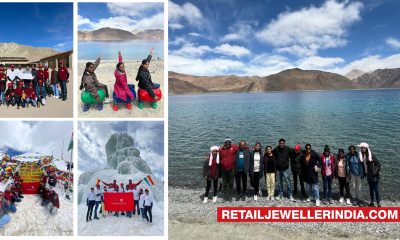RJ Market Watch
The “Earth” is what we all have in common! Yes with the proper use of science we can’t conquer nature but can live in it.

A research on Lab grown diamonds to break away from the conventional diamonds are slowly taking over the precious-stone landscape,
If the lab grown diamond is your next destination, SGL Lab certification has your back all the way !.with many retailers stocking these sustainable alternatives. With customers more aware now, The Retail Jeweller looks at a partner who can help you through the process, certifying and choosing the right stones for you
A post-Covid survey revealed something very interesting. Lab-grown diamonds are slowly spreading their roots in a predominantly mined-stone industry. The promise of forever with the age-old symbol of love is changing its origin from the core of the earth to a laboratory apparatus. While the industry suffered a blow during the pandemic-induced lockdown, lab-grown diamonds reported steady sales. MVEye, in a survey done in the US, found that 42% consumers prefer lab-grown diamonds over natural ones.
Today, the level of acceptance found among people regarding lab-grown diamonds has reached new heights. This awareness can be attributed to digital education or passive learning that has led to more purchasing activity. Consumers know why and how lab-grown diamonds are less expensive, yet are as rare as the naturally mined diamonds.

“In some extraordinary cases, we have seen customers, who previously paid huge amounts for solitaires in natural diamonds, now demanding lab-grown alternatives. This can be attributed to their satisfaction in price, quality, as well as their awareness around how there is no difference between lab-grown and natural-mined diamonds, which come in the same chemical and physical properties,” said Ankita Gupta, Founder & owner, Syndiora.

Prasad Kapre, consultant, CEO and director at Style Quotient Jewellery Private Limited, predicts lab-grown diamonds are the future. “Mines will exhaust in 20-25 years. No company will invest in new mines as there are lab-grown alternatives now. Diamonds have a demand of 40 million carats. In the next ten years, it will go up to 200 million carats. By 2050, mines will only bring 14 million carats into the market. The huge gap in demand can only be fixed by lab-grown diamonds,” he said.
If you are looking to stock lab-grown diamonds, the next thing that automatically comes up is certification. While retailers are aware about the process involved while grading natural diamonds, the knowledge is woefully limited in case of lab-grown diamonds. Who do you trust enough to grade them? Among most third-party certification centres, here is why SGL Labs is the choice you should make.

“Today the notion is, if it’s a small lab grown diamond, it is HPHT, and a large one is CVD. Instead, we now have HPHT technology that has improved, and stones up to one-and-a-half carats can be produced by the technology. This detail is elucidated in our certificate, which helps the trade make an informed decision. The consumer today is looking for eco-friendly options when it comes to jewellery. Another very important aspect of SGL is accountability. When we certify a diamond, we are also giving retailers the confidence to sell with knowledge and honesty. For a billion certificates we provide each year, the confidence we are instilling in the market is a huge thing,” says Chirag Soni, co-founder and director of SGL Labs.

“The difference between a natural and a lab-grown diamond is that one occurs naturally within the core of the earth while the other is grown in a laboratory. They are just conceived differently. The transparency that SGL provides is not something any other labs do and the legal implications in a market like the US is huge. We bear in mind the repercussions,” said Shirin Bandukwalla
The summer of 2019 saw a drop in prices for lab-grown diamonds. Later, it went up by about 22%, and has remained steady since. Even with Covid, the prices have not shown a plunge. The demand is robust and consistent because consumers are now looking at a sustainable and greener choice for their jewellery. Most millennials feel that sourcing a precious piece does not need to leave a hole in the ground. As a result, 38% of independent retailers are selling lab-grown diamonds now. “Only a handful of small chains remain that need to get inducted into the lab-grown revolution. Markets like Japan, who were not CVD-friendly, are also going up, Europe is going up. This is because the consumer now has a choice to make an eco-sensitive decision. For a mined diamond, there is a hole in the ground, deforestation, the question of labour, etc. Now, not only do we get the same product made in a lab, but it also costs about $1,000 less,” said Mr Soni.
“The difference between natural and lab-grown diamonds is that one is a billion years older whereas the other was recently grown; both are diamonds off course with similar properties, Said Ms Bandukwalla.
“This generation is very open to sustainable products; they are more aware and want to transform. They now realize that it’s high time to promote and use sustainable, eco-friendly products for a better future. Diamonds being a luxury product is more important to think about,” said Gupta. “Furthermore, the advantages of being inclined towards lab-grown diamonds are many. Now, loose lab-grown diamonds can be certified, the jewellery comes with a certificate from well-recognised labs. The transparency, therefore, creates more satisfaction. They also make an excellent choice from an investment point of view.”

If you want to know how retailers feel about SGL, the testimonials are aplenty. SGL exclusively certifies products for Limelight, one of the leading players in the lab-grown diamond sector. “SGL Labs has been our trusted lab-grown CVD diamond and jewellery certification agency for several years. While most labs offer the same services, what sets SGL apart is the quality of their service, particularly in terms of their pricing and their quick turnaround time, and their accountability. As a luxury brand for lab-grown CVD diamonds in India, and also a brand that promises complete transparency and honesty to our customers, we wanted partners who could support our core of being a complete ‘Make In India’ product. SGL labs has been the perfect choice for us,”, said Pooja Sheth, managing director and founder, Limelight Lab-Grown Diamonds Ltd.
Lab grown diamonds have two variants. This is where people get confused. The variants — CVD and HPHT —- refer to the way in which the diamond has been grown. For the consumer, all that matters is the gemological aspect, so they will always ask, “So what?”. CVD is the best form of lab-grown diamonds and this is where prices differ. The retailer needs to address this when they sell a product to the customer, so that the faith remains undeterred. “Today the notion is, if it’s a small diamond, it is HPHT, and a large one is CVD. This is not the case. We have HPHT technology that has improved, and you can find stones up to one-and-a-half carats. We make that certification clear for the trade to take an informed decision,” said Soni.
“With our certificates, there is a lot of transparency,” said Ms Bandukwalla.
“SGL follows all international certification standards, so they follow every norm specified. They have a database for each of their diamonds, which makes it easy to track all information related to the stone. This helps them recall and relook if there is a review needed. They are here for 13 years now and have the infrastructure required to certify. The best part about them is that they offer over 30 services other than certification. If all your jewellery needs can be taken care of under one roof, why would you go for someone else?” said Kapre.
Since lab-grown is what the world is looking at, why should we not welcome such a sustainable change? For the next step, we already have a helping hand with SGL Labs.
Courtesy: Retail Jeweller India News Service





 Daily News4 weeks ago
Daily News4 weeks agoBhima Jewels appoints Ram Charan as brand ambassador, aims to strengthen customer base in India and UAE

 Daily News5 days ago
Daily News5 days agoZoya raises a toast to its muse with designer Gauri Khan via vibrant gala

 Prime Story2 weeks ago
Prime Story2 weeks agoC Krishniah Chetty Group organizes 10-day Ladakh educational expedition for underprivileged students

 Daily News3 weeks ago
Daily News3 weeks agoKavitha Gold & Diamonds appoints actor Fahadh Faasil as brand ambassador, plans major expansion



















